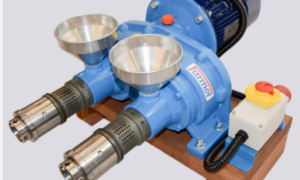Introduction
Before the commencement of any construction project, several essential steps must be taken to prepare the site. From land clearing and excavation to various site preparation processes, each stage plays a crucial role in laying the groundwork for successful construction. Among these steps, land grading stands out as a vital component. Land grading involves reshaping the terrain to establish a level surface with the desired slope and elevation, ensuring proper water drainage and stability for structures. In this article, we will explore the best equipment and techniques for achieving optimal land grading results, setting the stage for a solid foundation and successful construction projects.
Understanding the Importance of Land Grading
Land grading serves multiple critical purposes in the construction process. Firstly, it facilitates effective water drainage. By carefully shaping the land to create proper slopes and contours, land grading ensures that water flows away from the construction site, minimizing the risk of water accumulation and potential damage to the foundation. Additionally, land grading helps prevent erosion by controlling the flow of water and directing it towards appropriate drainage systems.
Secondly, land grading promotes stability for structures. By creating a level surface with an even distribution of soil, land grading minimizes the risk of differential settling, which can lead to cracks, uneven floors, and other structural issues. It provides a solid and stable base for the construction of buildings, roads, and other infrastructure.
Lastly, land grading optimizes the functionality of the constructed environment. By achieving the desired slope and elevation, land grading ensures that the site meets the specific needs of the project. Whether it’s creating a level playing field for sports facilities or establishing a smooth surface for roads, precise land grading enhances the usability and efficiency of the constructed space.
The Role of Land Grading Contractors
While some land grading projects can be undertaken by individuals or small construction teams, enlisting the services of experienced land grading contractors brings numerous advantages. Land grading contractors possess specialized knowledge and expertise in executing precise and efficient grading processes. They understand the intricacies of soil composition, drainage patterns, and the necessary equipment for achieving optimal results.
Land grading contractors, such as the trusted provider Shilling Excavation in Central Texas, offer comprehensive services tailored to the unique requirements of each construction project. They bring years of experience and a deep understanding of local regulations and best practices, ensuring that the land grading process adheres to industry standards and meets the specific needs of the project.
By collaborating with professional land grading contractors, construction teams can benefit from their expertise in site evaluation, equipment selection, and efficient execution of grading techniques. Moreover, working with reputable contractors provides peace of mind, knowing that the land grading process is in the hands of experts who prioritize safety, accuracy, and quality.
Essential Equipment for Land Grading
Graders are heavy machinery equipped with a long blade, also known as a moldboard or dozer blade, positioned between the front and rear axles. The blade is adjustable, allowing operators to control the depth and angle of the cut. Graders are highly versatile and commonly used in large-scale land grading projects, such as building sites, road construction, and sports fields.
The primary function of graders is to cut, spread, and level the soil. They are equipped with a powerful engine, hydraulic systems, and advanced controls, enabling precise and efficient grading operations. Graders excel in creating large, even surfaces by removing excess soil, redistributing it as needed, and achieving the desired slope and elevation across the construction site.
Excavators are another essential piece of equipment used in land grading projects. These machines feature a bucket or blade attachment mounted on a rotating platform, known as the house, and are operated using hydraulic systems. Excavators come in various sizes and configurations, allowing for versatility in different grading applications.
Excavators play a crucial role in land grading by excavating soil, rocks, and debris. They remove excess material to create the desired surface contours and provide a solid foundation for construction. Excavators can be equipped with grading buckets or rippers, depending on the specific grading requirements, ensuring precise and efficient soil removal and leveling.
Laser leveling systems have revolutionized the land grading process by providing a high level of accuracy and consistency. These systems utilize laser technology to guide the grading equipment and achieve precise results. A typical laser leveling system comprises three main components: a transmitter, a receiver, and a control panel.
The transmitter emits a laser beam, which is intercepted by the receiver mounted on the grading equipment. The receiver relays the information to the control panel, where the operator can monitor and make adjustments to achieve the desired grading specifications. Laser leveling systems offer advantages such as increased accuracy, reduced human error, and improved productivity, making them an invaluable tool for achieving precise land grading results.
Techniques for Effective Land Grading:
Before commencing the land grading process, a thorough site evaluation is essential. This evaluation involves analyzing the soil type, topography, drainage patterns, and potential obstructions present on the site. Understanding these factors allows land grading contractors to develop a comprehensive grading plan that addresses specific site requirements. Site evaluations may also involve conducting soil tests to determine soil compaction and composition, which further inform the grading approach.
The cut and fill technique is a commonly used method in land grading when there are significant variations in the site’s topography. It involves excavating soil from higher areas (cuts) and redistributing it to lower areas (fills) to create a level surface. The key to successful cut and fill grading is careful analysis of the site’s topography and soil characteristics. By strategically placing cuts and fills, land grading contractors can achieve the desired slope and elevation, ensuring a level surface for construction.
Slope stabilization is an integral part of land grading, especially in areas prone to erosion or landslides. Various techniques can be employed to enhance slope stability. Terracing, for example, involves creating stepped levels on steep slopes, reducing the risk of erosion and improving overall stability. Retaining walls are another effective method for stabilizing slopes by providing structural support and preventing soil movement. Additionally, planting vegetation on slopes helps to anchor the soil, control water runoff, and minimize erosion.
Benefits of Professional Land Grading:
Professional land grading ensures proper water drainage by creating well-designed slopes and contours that direct water away from the construction site. By preventing water accumulation, land grading helps protect the foundation of structures and minimizes the risk of water-related damage. Proper drainage is crucial for maintaining the longevity of the construction project and avoiding costly repairs in the future.
Precise land grading carried out by professionals eliminates uneven surfaces, reducing potential tripping hazards for workers and future occupants of the building. Moreover, accurate grading ensures stability and reduces the risk of soil instability, preventing landslides or slope failures that could compromise the safety of the construction site.
Investing in professional land grading can result in long-term cost savings. By ensuring proper soil compaction and drainage, land grading helps to minimize the risk of foundation problems. Properly graded land provides a solid base for construction, reducing the likelihood of uneven settling and structural issues that would require costly repairs or modifications in the future.
Conclusion
Land grading is a critical step in construction site preparation, ensuring a level surface, effective water drainage, and structural stability. By understanding the importance of land grading, working with experienced contractors, utilizing the essential equipment, employing effective techniques, and prioritizing accuracy, construction projects can achieve optimal land grading results. Professional land grading not only provides immediate benefits such as proper drainage and enhanced safety but also contributes to long-term cost savings by minimizing the risk of foundation problems. With meticulous planning and the right expertise, land grading sets the stage for successful and durable construction projects.



































